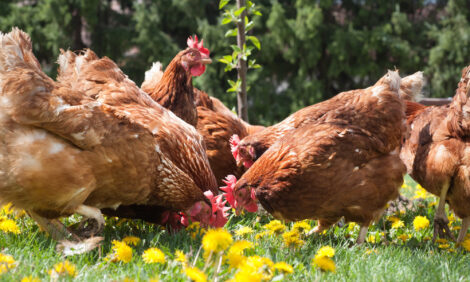



Six Steps to Starting Keeping Hens
US - There are six steps to ensure success at joining the "backyard revolution" and getting your own laying birds, according to one animal nutrition company."We can gain a lot from a backyard flock,” says Gordon Ballam, PhD, director of lifestyle innovation & technical service for Purina Animal Nutrition. “Chickens can produce truly fresh eggs and flavourful, healthy meat. And we’re able to enjoy watching birds from our back porch and teaching our children responsibilities and how animals grow.”
1. Select the Breed That's Right for You
Poultry breeds come in a variety of shapes, sizes and colours. Families looking to produce eggs or meat are encouraged to start with common breeds of chickens.
Dr Ballam said: “Determine what you’d like to gain from your flock.
“If you want fresh eggs, consider: White Leghorn hybrids (white eggs), Plymouth Barred Rocks (brown eggs), Rhode Island Reds (brown eggs), Blue Andalusians (white eggs) or Ameraucanas / Easter Eggers (blue eggs). Cornish Cross chickens grow quickly and are best suited for meat production. If you’re hoping to produce both eggs and meat, consider dual-purposed breeds like Plymouth Barred Rock, Sussex or Buff Orpingtons. Exotic breeds are best for show or pets.”
2. Determine the Number of Birds
The number and gender of birds in your flock may be determined by local ordinances and your flock goals.
Dr Ballam explained: “Remember that young chicks grow into full-grown birds. Create a budget for: the time you are able to spend with your flock; the housing the birds will require; a plan for how you’ll collect and use eggs; and what you’ll do with the birds after they retire from laying eggs. Then start small with a flock of four to six chicks.”
3. Research a Reputable Chick Supplier
Purchase chicks from a credible US Pullorum-Typhoid Clean hatchery. To prevent potential disease problems, ensure the hatchery vaccinated chicks for Marek’s Disease and coccidiosis.
4. Prepare Your Brooder
Keep baby chicks in a warm, draught-free shelter, called a brooder. The brooder should be completely enclosed with a bottom surface that can be covered with bedding; and have a heating lamp. Avoid square corners in the brooding area to prevent chicks from being trapped in the corner should the birds huddle in one area.
Dr Ballam recommended: “Each chick needs at least two to three square feet of floor space for the first six weeks. “Set the brooder temperature to 90 degrees Fahrenheit for the first week and then gradually reduce heat by five degrees Fahrenheit each week until reaching a minimum of 55 degrees Fahrenheit. Be sure to have a spacious, clean coop ready for the chicks once the supplemental heat source is no longer required. Through all stages, always provide plenty of fresh clean water that is changed daily.”
5. Focus on Sanitation
Before new chicks arrive – and throughout the growing process – be sure to keep their environment clean. Young chicks are susceptible to early health risks, so disinfect all materials prior to use and then weekly.
Dr Ballam said: “The correct household disinfectants can work well. Make sure to read the directions to ensure your disinfectant is safe to use and doesn’t leave a residual film. A mixture of 10 per cent bleach and 90 per cent water can work well, if the cleaner is rinsed thoroughly following cleaning.”
6. Create a Long-term Nutrition Plan
A healthy full-grown bird begins on day one. Provide a balanced starter diet to new chicks, based on their breed traits.
To learn more about backyard flock nutrition, visit www.purinamills.com/chicken-feed or like Purina Poultry on Facebook.









